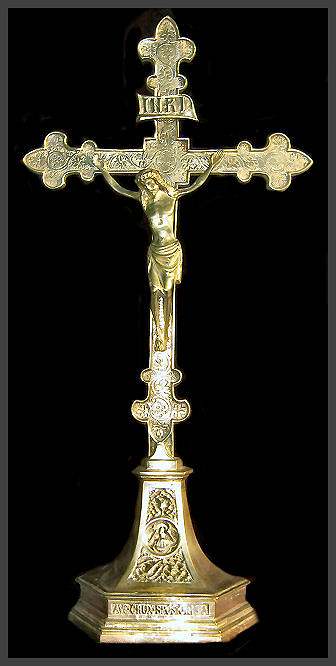 For et par uker siden mottok jeg et nytt alterkrusifiks, som man kan se på bildet til venstre. Jeg fikk tak i et par mindre krusifikser til å ha på alteret for et års tid siden, men det nye er finere og større (61 cm høyt). Jeg har begynt å bruke et slikt krusifiks etter pave Benedikts anbefaling (selvsagt), og merker at det hjelper meg å rette oppmerksonheten bedre mot Kristus, og bort fra folkene som sitter rett foran meg. Noen syns kanskje det høres underlig ut, men det er jo til Gud man ber når man står foran alteret.
For et par uker siden mottok jeg et nytt alterkrusifiks, som man kan se på bildet til venstre. Jeg fikk tak i et par mindre krusifikser til å ha på alteret for et års tid siden, men det nye er finere og større (61 cm høyt). Jeg har begynt å bruke et slikt krusifiks etter pave Benedikts anbefaling (selvsagt), og merker at det hjelper meg å rette oppmerksonheten bedre mot Kristus, og bort fra folkene som sitter rett foran meg. Noen syns kanskje det høres underlig ut, men det er jo til Gud man ber når man står foran alteret.
Da jeg i dag leste følgende tekst av pavens seremonimester, msgr. Guido Marini, tekte jeg på mitt nye krusifiks. Han sier bl.a. dette i et intervju:
… you have earlier highlighted the key changes since taking the post of Master of Papal Liturgical Celebrations. Could you recall and explain what these mean?
I was just saying that the changes to which you refer are to be understood as a sign of a development in continuity with the recent past, and I remember one in particular: the location of the cross at the centre of the altar. This positioning has the ability to express, also by external sign, proper orientation at the time of the celebration of the Eucharistic Liturgy, that the celebrant and the assembly do not look upon each other but together turn toward the Lord. Also, the unity of the altar and cross together can better show forth, together with the «banquet» aspect, the sacrificial dimension of the Mass, whose significance is always essential, I would say it springs from it, and therefore, always needs to find a visible expression in the rite.
I intervjuet sier msgr. Marini også følgende om den utvida tillatelsen til å bruke den gamle messen:
The Motu Proprio «Summorum Pontificum» is presented as the most important activity in the papacy of Benedict XVI. What is your opinion?
I do not know whether it is the most important but it certainly is an important document. It is not only so because it is a very significant step towards a reconciliation within the Church, not only because it expresses the desire to arrive at a mutual enrichment between the two forms of the Roman Rite, the ordinary and extraordinary, but also because it is the precise indication, in law and liturgy, of that theological continuity which the Holy Father has presented as the only correct hermeneutic for reading and understanding of the life of the Church and, especially, of Vatican II.
